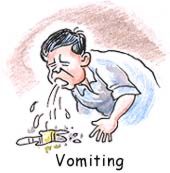
Salmonellosis
Salmonellosis (say: sal-muh-neh-loh-sis) is an illness caused by Salmonella (say: sal-muh-neh-luh) bacteria. If the bacteria find their way into a person's stomach and intestines, they can cause cramps, nausea, vomiting, and diarrhea. There are several different types, or strains, of Salmonella bacteria, and they all can make you sick.
Salmonella can be found in soil, water, raw food, and the bowel movements (poop) of some animals, including reptiles like turtles and snakes. Some kids get sick because of a pet or other animal. If poop gets on the animal's skin, the bacteria will get on the skin, too. Then if a person touches the animal, she can get the bacteria and might develop salmonellosis.
Someone also can be infected if he or she eats food that has not been handled or prepared well. Sometimes Salmonella bacteria are found in raw foods - such as eggs, milk, chicken, turkey, and meat - that have touched animal poop. If these foods are not processed or cooked well, the bacteria stay alive in the food and can infect someone who eats it.
People who have salmonellosis have the bacteria in their own poop, too. So if the sick person doesn't wash his or her hands carefully after using the bathroom, and then touches food, the bacteria can get in the food and spread to other people. Also, children in diapers who have salmonellosis can spread the infection because their poop will be infected. People who change the child's diapers could get the infection that way.
How Can I Prevent Salmonellosis?
Because Salmonella bacteria are spread through poop, one of the best ways to prevent illness is to wash your hands often with warm water and soap. Make a special effort to wash your hands in these situations:
right after playing with a pet or animal (especially a reptile or chicken)
right after you use the bathroom
before preparing any food, like cutting up vegetables for dinner
before eating any food
That's a lot of hand washing, but it's worth it! Even if you were to get Salmonella bacteria on your hands, you will get rid of them before they can make you sick.
You also might remind other members of your family to wash their hands often. People who cook meals should wash their hands before touching any food. It's also a good idea to use water and soap to clean kitchen counters, cutting boards, and knives after they touch raw foods.
Another way to protect against Salmonella infection is to never eat raw or undercooked eggs, meat, chicken, or turkey. Meat, chicken, and turkey should be cooked until they are no longer pink in the center, and eggs should be cooked so they aren't wet and runny. Raw fruit and vegetables make healthy snacks, but be sure to wash them well before you start munching.
If you're choose a reptile for a pet, remember that many reptiles carry Salmonella. Be sure everyone washes up after touching the animal or the cage.

How Do I Know if I Have It?
People who get salmonellosis may have these symptoms:
nausea
vomiting
painful stomach cramps
diarrhea, which could be bloody
Salmonellosis also may cause a headache and fever. Keep in mind that other illnesses also can cause all these symptoms, so it's important to tell your parent and see a doctor to figure out if you have salmonellosis.
Salmonellosis






